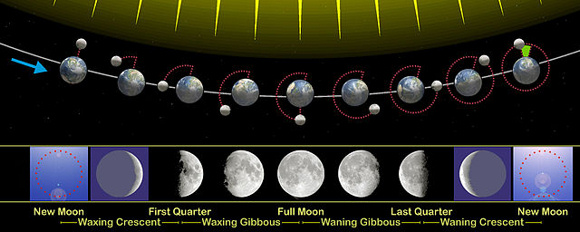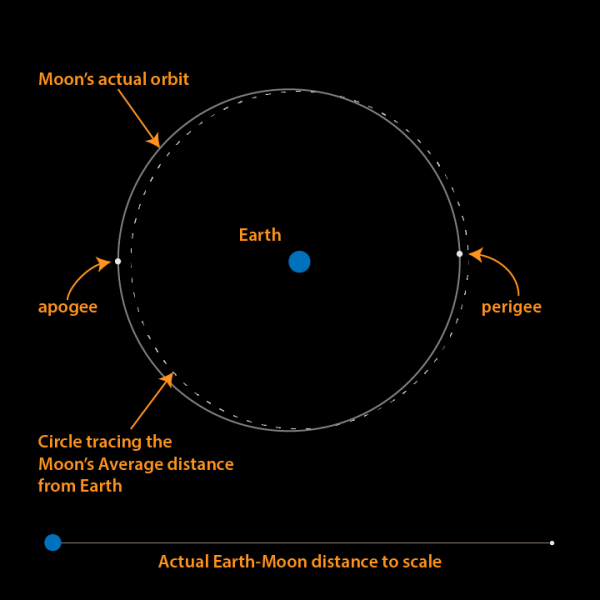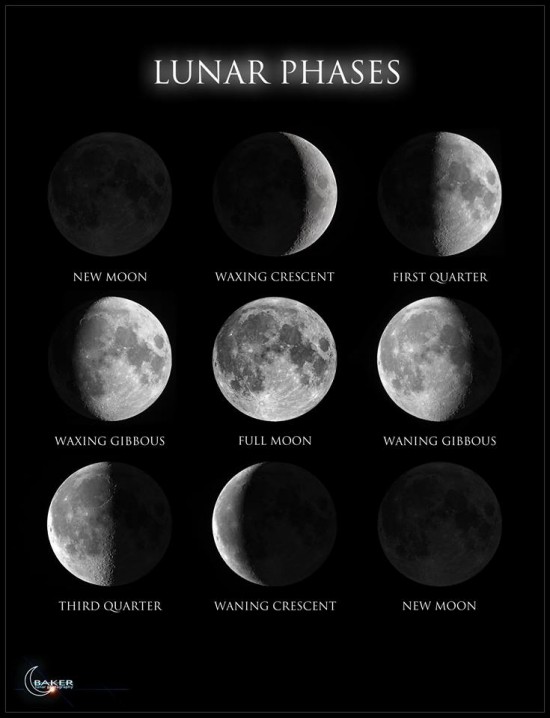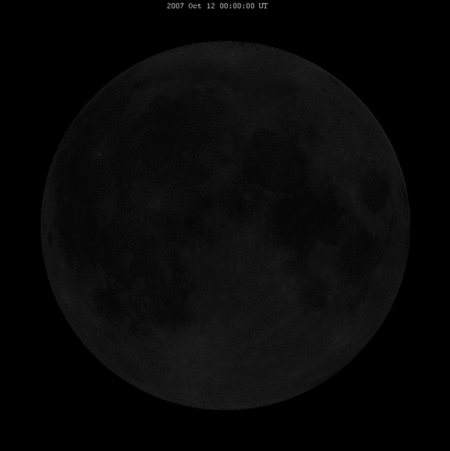
What is a lunar month? It’s simply the duration between successive new moons. Also called a lunation or synodic month, it has a mean period of 29.53059 days (29 days 12 hours and 44 minutes). That’s the mean, but the the true length varies throughout the year.
The longest lunar month in 2020 starts with the new moon on February 23, and concludes with the new moon on March 24. Its duration will be 29 days 17 hours and 56 minutes.
The shortest lunar month of 2020 starts with the August 19 new moon and ends with the new moon on September 17, lasting 29 days 8 hours and 19 minutes.
This year’s longest lunar month (January 24 to February 23) is 5 hours and 12 minutes longer than the mean lunar month, and the shortest lunar month (August 19 to September 17) is 4 hours and 25 minutes shorter than the mean lunar month.
Added all up, the duration of the year’s longest lunar month is 9 hours and 37 minutes greater than that of the shortest lunar month.
Follow the links below to learn more:
Lengths of the lunar months in 2020
Why are lunar months different lengths?
When are the longest and shortest lunar months of the 21st century?
Lengths of the lunar months in 2020
| Successive new moons | Length of lunar month | |
| Dec 26, 2019, to Jan 24, 2020 | 29 days 16 hours 29 min | |
| Jan 24 to Feb 23 | 29 days 17 hours 50 min | |
| Feb 23 to Mar 24 | 29 days 17 hours 56 min | |
| Mar 24 to Apr 23 | 29 days 16 hours 58 min | |
| Apr 23 to May 22 | 29 days 15 hours 13 min | |
| May 22 to Jun 21 | 29 days 13 hours 03 min | |
| Jun 21 to Jul 20 | 29 days 10 hours 52 min | |
| Jul 20 to Aug 19 | 29 days 09 hours 09 min | |
| Aug 19 to Sep 17 | 29 days 08 hours 19 min | |
| Sep 17 to Oct 16 | 29 days 08 hours 31 min | |
| Oct 16 to Nov 15 | 29 days 09 hours 36 min | |
| Nov 15 to Dec 14 | 29 days 11 hours 09 min | |
| Dec 14, 2020, to Jan 13, 2021 | 29 days 12 hours 44 min |
Sources: Astropixels.com and TimeandDate.com

One lunar month is the period of time from new moon to new moon. As viewed from the north side of the Earth’s and moon’s orbital planes, the Earth goes counterclockwise around the sun and the moon goes counterclockwise around Earth. Image via Wikipedia.
Why are the lunar months different lengths? In a nutshell, the longest lunar month occurs when the successive new moons coincide closely with lunar apogee – the moon’s farthest point from Earth in its orbit.
In contrast, the year’s shortest lunar month takes place when the successive new moons fall appreciably close to lunar perigee – the moon’s closest point to Earth in its orbit.
On the average, the lunar month (new moon to new moon) is about 2.22 days longer than the sidereal month (one complete revolution of the moon relative to the background stars). However, if the moon is near apogee at the end of one sidereal month, the moon travels more slowly than average in its orbit. Therefore, the period of time between the end of the sidereal month and the end of the lunar month is longer than average.
The opposite is the case when the moon is near perigee. The moon travels more swiftly in its orbit at perigee, in which case the time period between the end of the sidereal month and the end of the lunar month is less than average.
Dates for the 14 apogees and 13 perigees in 2020
The most extreme longest lunar months happen when successive new moons occur near lunar apogee – and in addition, when Earth is near perihelion (its closest point to the sun). Because Earth is always closest to the sun in early January, the very longest lunar months take place between December and January new moons.
On the other hand, extremely short lunar months happen when successive new moons fall near lunar perigee – and in addition, the Earth is near aphelion (Earth’s farthest point from the sun in its orbit). Because Earth is always at aphelion in early July, the very shortest lunar months take place between June and July new moons.
Enjoying EarthSky so far? Sign up for our free daily newsletter today!

The variation in the length of lunar months happens because the moon’s orbit around Earth is not a perfect circle. However, it is very nearly circular, as the above diagram shows. Diagram by Brian Koberlein.
When are the longest and shortest lunar months of the 21st century? The longest lunar month of the 21st century (2001 to 2100) occurs between the December 2017 and January 2018 new moons. With a length of 29 days 19 hours and 47 minutes, this particular lunar month exceeds the mean by a whopping 7 hours and 3 minutes.
The century’s shortest lunar month takes place between the new moons of June and July 2053, a period of 29 days 6 hours and 35 minutes. That’s 6 hours and 9 minutes shorter than the mean.
Incidentally, exceptionally long or short lunar months repeat in cycles of 9 years.

Phases of the moon, posted to EarthSky Facebook by our friend Jacob Baker.
Best New Year’s gift ever! EarthSky moon calendar for 2020
Bottom line: In 2020, the shortest lunar month happens between the August 19 and September 17 new moons; and the longest one between the February 23 and March 24 new moons. See Astropixel.com’s complete list of the length of each lunar month in the 21st century.
from EarthSky https://ift.tt/2FugP1m

What is a lunar month? It’s simply the duration between successive new moons. Also called a lunation or synodic month, it has a mean period of 29.53059 days (29 days 12 hours and 44 minutes). That’s the mean, but the the true length varies throughout the year.
The longest lunar month in 2020 starts with the new moon on February 23, and concludes with the new moon on March 24. Its duration will be 29 days 17 hours and 56 minutes.
The shortest lunar month of 2020 starts with the August 19 new moon and ends with the new moon on September 17, lasting 29 days 8 hours and 19 minutes.
This year’s longest lunar month (January 24 to February 23) is 5 hours and 12 minutes longer than the mean lunar month, and the shortest lunar month (August 19 to September 17) is 4 hours and 25 minutes shorter than the mean lunar month.
Added all up, the duration of the year’s longest lunar month is 9 hours and 37 minutes greater than that of the shortest lunar month.
Follow the links below to learn more:
Lengths of the lunar months in 2020
Why are lunar months different lengths?
When are the longest and shortest lunar months of the 21st century?
Lengths of the lunar months in 2020
| Successive new moons | Length of lunar month | |
| Dec 26, 2019, to Jan 24, 2020 | 29 days 16 hours 29 min | |
| Jan 24 to Feb 23 | 29 days 17 hours 50 min | |
| Feb 23 to Mar 24 | 29 days 17 hours 56 min | |
| Mar 24 to Apr 23 | 29 days 16 hours 58 min | |
| Apr 23 to May 22 | 29 days 15 hours 13 min | |
| May 22 to Jun 21 | 29 days 13 hours 03 min | |
| Jun 21 to Jul 20 | 29 days 10 hours 52 min | |
| Jul 20 to Aug 19 | 29 days 09 hours 09 min | |
| Aug 19 to Sep 17 | 29 days 08 hours 19 min | |
| Sep 17 to Oct 16 | 29 days 08 hours 31 min | |
| Oct 16 to Nov 15 | 29 days 09 hours 36 min | |
| Nov 15 to Dec 14 | 29 days 11 hours 09 min | |
| Dec 14, 2020, to Jan 13, 2021 | 29 days 12 hours 44 min |
Sources: Astropixels.com and TimeandDate.com

One lunar month is the period of time from new moon to new moon. As viewed from the north side of the Earth’s and moon’s orbital planes, the Earth goes counterclockwise around the sun and the moon goes counterclockwise around Earth. Image via Wikipedia.
Why are the lunar months different lengths? In a nutshell, the longest lunar month occurs when the successive new moons coincide closely with lunar apogee – the moon’s farthest point from Earth in its orbit.
In contrast, the year’s shortest lunar month takes place when the successive new moons fall appreciably close to lunar perigee – the moon’s closest point to Earth in its orbit.
On the average, the lunar month (new moon to new moon) is about 2.22 days longer than the sidereal month (one complete revolution of the moon relative to the background stars). However, if the moon is near apogee at the end of one sidereal month, the moon travels more slowly than average in its orbit. Therefore, the period of time between the end of the sidereal month and the end of the lunar month is longer than average.
The opposite is the case when the moon is near perigee. The moon travels more swiftly in its orbit at perigee, in which case the time period between the end of the sidereal month and the end of the lunar month is less than average.
Dates for the 14 apogees and 13 perigees in 2020
The most extreme longest lunar months happen when successive new moons occur near lunar apogee – and in addition, when Earth is near perihelion (its closest point to the sun). Because Earth is always closest to the sun in early January, the very longest lunar months take place between December and January new moons.
On the other hand, extremely short lunar months happen when successive new moons fall near lunar perigee – and in addition, the Earth is near aphelion (Earth’s farthest point from the sun in its orbit). Because Earth is always at aphelion in early July, the very shortest lunar months take place between June and July new moons.
Enjoying EarthSky so far? Sign up for our free daily newsletter today!

The variation in the length of lunar months happens because the moon’s orbit around Earth is not a perfect circle. However, it is very nearly circular, as the above diagram shows. Diagram by Brian Koberlein.
When are the longest and shortest lunar months of the 21st century? The longest lunar month of the 21st century (2001 to 2100) occurs between the December 2017 and January 2018 new moons. With a length of 29 days 19 hours and 47 minutes, this particular lunar month exceeds the mean by a whopping 7 hours and 3 minutes.
The century’s shortest lunar month takes place between the new moons of June and July 2053, a period of 29 days 6 hours and 35 minutes. That’s 6 hours and 9 minutes shorter than the mean.
Incidentally, exceptionally long or short lunar months repeat in cycles of 9 years.

Phases of the moon, posted to EarthSky Facebook by our friend Jacob Baker.
Best New Year’s gift ever! EarthSky moon calendar for 2020
Bottom line: In 2020, the shortest lunar month happens between the August 19 and September 17 new moons; and the longest one between the February 23 and March 24 new moons. See Astropixel.com’s complete list of the length of each lunar month in the 21st century.
from EarthSky https://ift.tt/2FugP1m


Aucun commentaire:
Enregistrer un commentaire